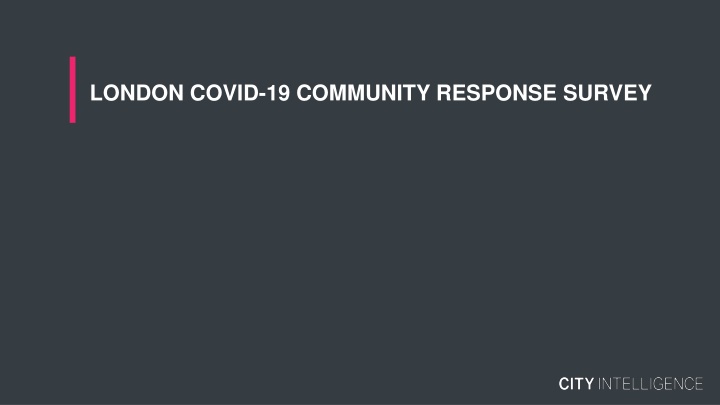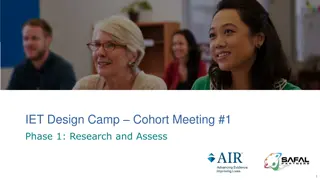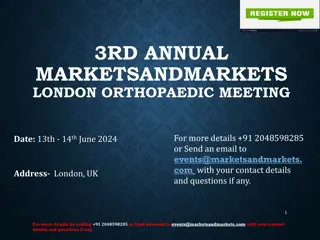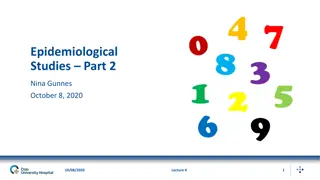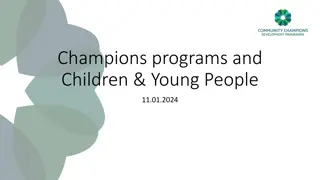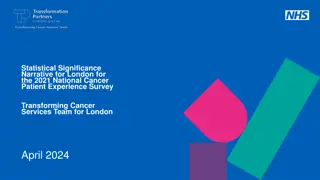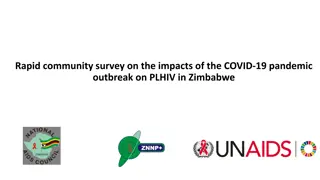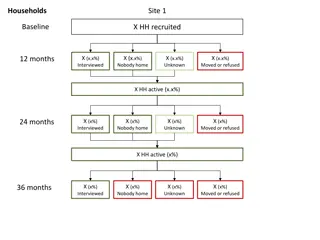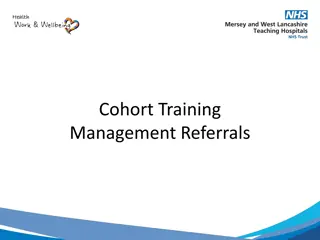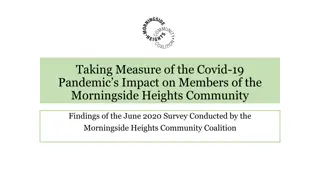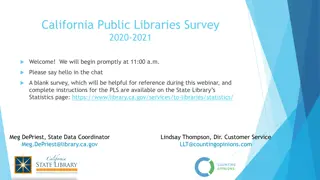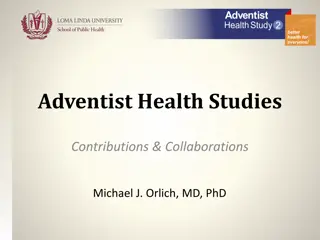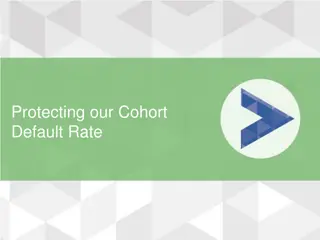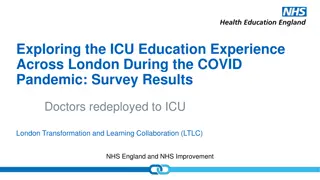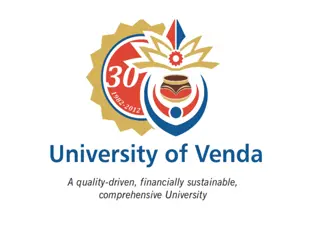London COVID-19 Community Response Survey Cohort Details
The London COVID-19 Community Response Survey focuses on understanding the impact of COVID-19 and associated policy measures on vulnerable populations in London. Approximately 260 civil society organizations are part of the cohort, with weekly responses shedding light on the immediate effects post-lockdown. The survey covers all London boroughs (excluding City of London) and addresses a wide range of beneficiary groups served by the organizations.
Download Presentation

Please find below an Image/Link to download the presentation.
The content on the website is provided AS IS for your information and personal use only. It may not be sold, licensed, or shared on other websites without obtaining consent from the author.If you encounter any issues during the download, it is possible that the publisher has removed the file from their server.
You are allowed to download the files provided on this website for personal or commercial use, subject to the condition that they are used lawfully. All files are the property of their respective owners.
The content on the website is provided AS IS for your information and personal use only. It may not be sold, licensed, or shared on other websites without obtaining consent from the author.
E N D
Presentation Transcript
INTRODUCTION Purpose of the Community Response Survey Cohort details The weekly COVID-19 Community Response Survey will ask civil society organisations that work in London a small number of questions to understand the impact of COVID-19 and associated policy measures, such as social distancing, on vulnerable populations in the capital. The cohort is now made up of approximately 260 organisations, with 100-120 responding to the survey each week. The organisations were recruited through existing contacts and mailing lists held by teams within the GLA. In addition, larger organisations, funders and infrastructure providers were asked to cascade the invitation down to their networks The first week of the survey focused on baseline questions to capture organisational profile, and included a small number of questions relating to the immediate impact post-lockdown of COVID-19. Note: due to the relatively small sample size and the targeted way in which recruitment was conducted, it is important not to extrapolate from any findings in the weekly survey to all civil society organisations in London or any particular population of Londoners. Results from the weekly survey should be used alongside other sources of intelligence to understand the ongoing impact of COVID- 19 on vulnerable communities Where possible, baseline questions were adapted from questions asked in the 2010 Survey of Third Sector Organisations. The week 6 survey is currently in the field for responses, closing on the 21st of May. Results from the survey will be shared with responding organisations and with decision-makers supporting the pan- London response to COVID-19. They are also published on the London Data store: https://data.london.gov.uk/dataset/london- community-response-survey
GEOGRAPHY All boroughs (with the exception of City of London) are represented in the cohort. 40 responding organisations work across the whole of London. Borough Pan-London Barking and Dagenham Barnet Bexley Brent Bromley Camden Croydon Ealing Enfield Greenwich Hackney Hammersmith and Fulham Haringey Harrow Havering Hillingdon Number 41 16 18 8 21 13 25 18 15 14 18 26 20 16 16 8 16 Borough Hounslow Islington Kingston upon Thames Lambeth Lewisham Merton Newham Redbridge Richmond upon Thames Kensington and Chelsea Southwark Sutton Tower Hamlets Waltham Forest Wandsworth Westminster Number 15 16 17 25 19 14 16 9 15 19 21 12 30 27 22 23 Source: COVID-19 Community Response Survey (n=212)
BENEFICIARIES/SERVICE USERS Responding organisations were asked Thinking about the last 12 months, which of the groups listed below are users / beneficiaries of your organisation? Their responses suggest that most organisations in the cohort work with a range of groups. On average, respondents ticked 10 different groups. User/beneficiary groups BAME Londoners Women Socially excluded /lonely/vulnerable people Young people (aged 16 to 24) People with mental health needs Men Older people Children (aged 15 and under) Asylum seekers/refugees/migrants People with a particular financial need (including poverty) Homeless people Carers/parents People with learning difficulties Number 89 87 86 77 77 75 66 66 66 65 62 58 57 User/beneficiary groups Physically disabled/access needs LGBT+ people People with addiction problems Other third sector organisations The general public Physical health needs Victims of crime and their families Offenders, ex-offenders and their families Transgender and non-binary specific Faith communities Deaf people and/or people with a visual impairment Number 56 48 43 42 40 40 38 37 32 29 17 Source: COVID-19 Community Response Survey (n=140)
MAIN BENEFICIARIES/SERVICE USERS Responding organisations were asked Thinking about the last 12 months, which of the groups listed below are the main users / beneficiaries of your organisation? Where possible the results of this question are matched to weekly surveys to understand which populations may be experiencing greater need over time. User/beneficiary groups Young people (aged 16 to 24) The general public Children (aged 15 and under) BAME Londoners Socially excluded /lonely/vulnerable people Homeless people Asylum seekers/refugees/migrants People with mental health needs People with a particular financial need (including poverty) Older people Carers/parents People with learning difficulties Women Number 44 40 32 30 30 28 24 22 19 17 16 16 16 User/beneficiary groups Victims of crime and their families Other third sector organisations Physically disabled/access needs Offenders, ex-offenders and their families LGBT+ people People with addiction problems Faith communities Transgender and non-binary specific Physical health needs Deaf people and/or people with a visual impairment Men Number 15 14 12 9 9 8 5 4 2 1 1 Source: COVID-19 Community Response Survey (n=188)
AREAS OF WORK Responding organisations were asked In which of the areas listed below does your organisation work? Their responses suggest that the majority of responding organisations provide health and well-being and/or advice and support services. We also have a number of responding organisations working on specific issues relating to equalities/civil rights, criminal justice, capacity-building and culture/leisure. We have relatively few organisations providing religious/faith-based activities, and may look to recruit more in this area. Area of work Health and well-being Advice and support services Community development and mutual aid Number Area of work 88 Capacity-building and other support 79 Equalities / civil rights 65 Supporting victims of crime or their families Supporting offenders, ex-offenders or their families 59 Other charitable, social or community purposes 59 Environment / sustainability 57 Religious / faith-based activity 56 Heritage 44 Number 41 32 27 Cohesion / civic participation Accommodation/housing Training Education and lifelong learning Economic well-being Culture and leisure (including arts, music, sport and recreation) 64 20 17 11 11 10 Source: COVID-19 Community Response Survey (n=141)
CHANGE IN NUMBERS SEEKING SUPPORT EACH WEEK 70 60 50 40 30 20 10 0 Week 2 Week 3 Week 4 Week 5 Lower About the same Higher
CHANGE IN NUMBERS SEEKING SUPPORT FOR SPECIFIC ISSUES We asked responding organisations to tell us whether the number of people seeking support for a range of specific issues was higher, the same or lower compared to last week. We asked them to only answer if they deal with and have seen each of the issues. Capacity building has risen as an issue in the latest week data, compared to last weeks. Issue Proportion reporting higher demand No. of responses Issue Proportion reporting higher demand No. of responses Isolation and loneliness Mental health Digital connectivity Poverty Debt issues Housing Capacity Building Domestic violence Employment Access to benefits 64% 58% 57% 56% 48% 47% 47% 45% 44% 44% 72 81 65 52 52 57 51 47 52 62 Physical health Grief bereavement Childcare or Parenting Access to food Access to health Access to care Immigration issues Discrimination Victim support 39% 39% 36% 32% 29% 28% 27% 26% 22% 51 44 42 68 58 50 41 39 36 Source: COVID-19 Community Response Survey Week 5
CHANGE IN NUMBERS SEEKING SUPPORT FOR SPECIFIC ISSUES Week 2 Week 3 Week 4 Week 5 Isolation and loneliness Mental health Mental health Isolation and loneliness Mental health Digital connectivity Isolation and loneliness Mental health Poverty Isolation and loneliness Digital connectivity Digital connectivity Digital connectivity Debt issues Housing Poverty Access to food Access to benefits Poverty Debt issues Access to benefits Poverty Access to food Housing Housing Access to food Domestic violence Domestic violence Grief bereavement Housing Access to benefits Access to benefits Debt issues Domestic violence Debt issues Grief bereavement Domestic violence Grief bereavement Access to care Access to food Access to care Access to care Grief bereavement Access to care
WHAT IS THE BIGGEST CHALLENGE YOUR BENEFICIARIES ARE FACING THIS WEEK? We asked responding organisations to tell us the three biggest challenges their beneficiaries were facing in the last week. A slightly greater number of organisations are reporting issues around mental health, isolation and digital exclusion than issues such as job loss, low incomes and access to food and essentials. Challenge Number of organisations Issue Number of organisations Mental health 43 Inadequate accommodation 10 Digital exclusion 41 Access to local authority support <10 Social Isolation 35 Family tension <10 Jobs/employment 21 Domestic violence <10 Access to food and essentials 19 No recourse to public funds <10 Social distancing rules 18 Bereavement <10 Low income 17 Multi-lingual support <10 Access to benefits 13 Eviction <10 Source: COVID-19 Community Response Survey Week 5
BENEFICIARY CHALLENGES BY BENEFICIARY GROUP Do biggest beneficiary challenges vary by the main groups of beneficiaries organisations work with? Organisations working with young people were particularly likely to mention social isolation: half of these organisations mentioned it, versus 1 in 10 orgs working with BAME Londoners and a third of orgs working with socially excluded/vulnerable Londoners Organisations working with BAME Londoners were particularly likely to mention digital exclusion: half of these organisations mentioned it, versus under a third of orgs working with young or socially excluded/vulnerable Londoners Organisations working with socially excluded/vulnerable Londoners and those working with BAME Londoners were more likely to mention loss of jobs or lack of employment opportunities than those working with young Londoners, almost half of these organisations mentioned it, versus less than 1 in 5 or organisations working with young people
WHAT IS THE BIGGEST CHALLENGE YOUR ORGANISATION IS FACING THIS WEEK? We asked responding organisations to tell us the three biggest challenges they were facing last week. By far the most common challenges were around longer-term funding and recovery planning Challenge Number of organisations Issue Number of organisations Planning for recovery/easing of lockdown 43 Personal Protective Equipment 11 Funding - sustainability beyond the crisis 36 Capacity - due to staff working from home 10 Maintaining contact with beneficiaries 21 Digital skills or training 10 Staff wellbeing and mental health 21 Difficulty in delivering services online <10 Digital or tech equipment 18 Working with local authorities <10 Funding - general 18 Capacity - due to furloughed staff <10 Capacity - due to increased demand 17 Capacity - general <10 Need to provide new/changed services 17 Funding - relationship with existing funders <10 Reaching vulnerable groups 16 Advice/training on supporting vulnerable <10 Social distancing in delivery 13 Capacity - due to reduction in volunteers <10 Funding - access to urgent funds 12 Source: COVID-19 Community Response Survey Week 5
What support needs have you identified for your beneficiaries and your organisation as we move into the recovery period? Week 4 Delivering services whilst maintaining social distancing (43) Groups shared concerns about access to PPE, impracticality of maintaining social distance in a small office space and the need to completely shift how they deliver in order to follow guidance. Groups also indicated a need for clear and consistent guidance for civil society groups. Space: we already struggled with too little space, but are struggling to plan a way to deliver services that would allow for distance both within our office and between beneficiaries in group activities; we envisage needing more staff in order to open for extended hours as we will not be able to have such a high volume of people on site as before. Mental health needs of our beneficiaries (LGBT people). The early discussions are still including social distancing measures, which we feel will not help ease isolation or allow us to provide face to face group services which are aimed at reducing this in the early stages. Our office is cramped, and we could not safely manage 2 metre distancing for our staff and volunteers needing desk access, and only manage a VERY reduced capacity in our group spaces.
Groups whose needs are not being met by the current support available in response to COVID-19 Week 4 49 groups responded to this question. The most commonly occurring groups were: - Disabled people (8) - Gypsy, Rome or Travellers (7) - NRPF (6) - LGBTQ+ (5) - Homeless Londoners (5) - BAME groups (4) - Freelancers or self employed workers (4) The current situation has exaggerated 'normal' inequalities. That means that those who are discriminated against on a normal day on grounds of race, disability and sexuality are facing yet more barriers to support.
Impact of survey The results of the survey have been shared with the cohort, Strategic Coordination Group, teams across the GLA, boroughs, funders and others. Also available publicly. Informing priorities for the London Community Response Fund. Fed in to conversations regarding additional funder plus support. Citing evidence in advocacy that the GLA and others are carrying out to support the sector and vulnerable communities. Further analysis on digital exclusion, NRPF and access to food. Support for the sector e.g. this briefing.
Any other issues to flag The loosening of shut in coupled with fear of virus loss of income rise in food prices and bills starting to come in is almost a perfect storm of disaster for many families who were financially independent. People are finding it upsetting and incomprehensible that they are in this situation. It is damaging people physically and mentally.
